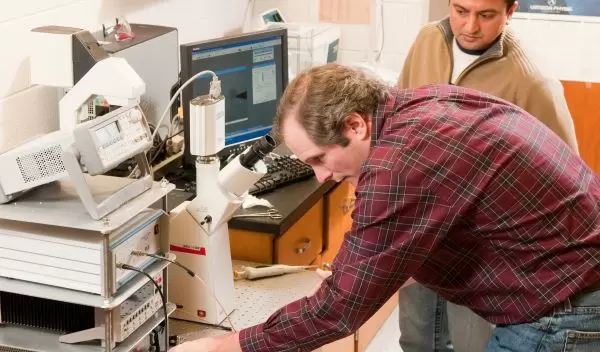
Electrical Nanowires Probe Individual Cells
Kansas State University researchers are growing tiny electric wires called "nanowires," one one-thousandth of the diameter of a human hair, to electrically stimulate a single cell and study the cell's response. Electrical stimulation opens ion channels in the cellular membrane, enabling the passage of ionic currents that tell cells how to respond to their environment. Technologies for locally stimulating these ion currents will help scientists understand tissue-level processes, such as how wounds heal. This technology may also be applied to other conditions such as cardiac hypertrophy and cystic fibrosis, which result when normal current flow across the membrane is compromised.
Although it was possible to fabricate such wires with existing techniques, growing and interconnecting wires with easily tunable diameters in a single-step process was not possible until Kansas State researchers invented a new process called Directed Electrochemical Nanowire Assembly, or DENA.
"The process is actually a form of crystallization similar to the one that makes snowflakes grow," said associate professor of physics Bret Flanders. Snowflakes grow with a variety of shapes, but always with an underlying hexagonal structure, and often with branchless, needle-shaped spikes extending from each of the six corners. This variety reflects the different regions of temperature and humidity that the snowflake falls through on its way to the ground.
Through precise control of experimental conditions, DENA replicates the needle-growth process to fabricate branchless metallic crystals that serve as current carrying nanowires. By restricting the deposition process to occur only in one direction, DENA produces a single metallic wire instead of the six dendrites that grow simultaneously during snowflake-growth.
The DENA process consists of applying an alternating voltage across two electrodes immersed in salt solution. The variable voltage induces the deposition of the metallic species into a wire that grows between the two electrical contacts. Varying the frequency of the alternating voltage influences both the growth velocity and the diameter of the wire-the higher the frequency, the smaller the diameter. As a result, DENA produces nearly perfectly formed nanowires, and the nanowire-diameter can be precisely tuned to less than 50 nanometers--how much less depends on the metal. Applying a small negative voltage to the nanowire induces a nearby cell to form a temporary projection called a "pseudopod" that connects the nanowire to the cell. There is a -45 millivolt threshold for cell-to-wire attachment. Below this voltage, attachment is rare, above this voltage, attachment is a 70 percent probability.
Because of their small size compared to normal wires, nanowires allow researchers to make spatially precise measurements of a cell's physiological response to the wire's electrical stimulation. The cell-to-wire attachment technology is especially suited to cellular migration studies, because individual parts of the cell, referred to as "pseudopodia," must anchor themselves to substrate-features like the wire-tip to move the cell. The Flanders group is observing the cell-induced deflection of a flexible polymeric nanowire to which the cell is attached to characterize the force exerted by a single pseudopod during the migration of a cell.
The DENA technique requires only standard laboratory instrumentation and facilities, so it's available to the broader research community, Flanders noted. "It will be a useful tool for neuroscientists because it allows for the study of ion transport across single ion channels at very high spatial and likely temporal resolution."
Exploratory research grants from the National Science Foundation enabled Flanders to initiate this research while an assistant professor at Oklahoma State University. In August 2008, he moved his research group to Kansas State University to join its growing soft matter physics group.
"With five principal investigators all focusing on interdisciplinary problems in nanobiological physics, this group provides a stimulating community for further development of these techniques," Flanders said.


